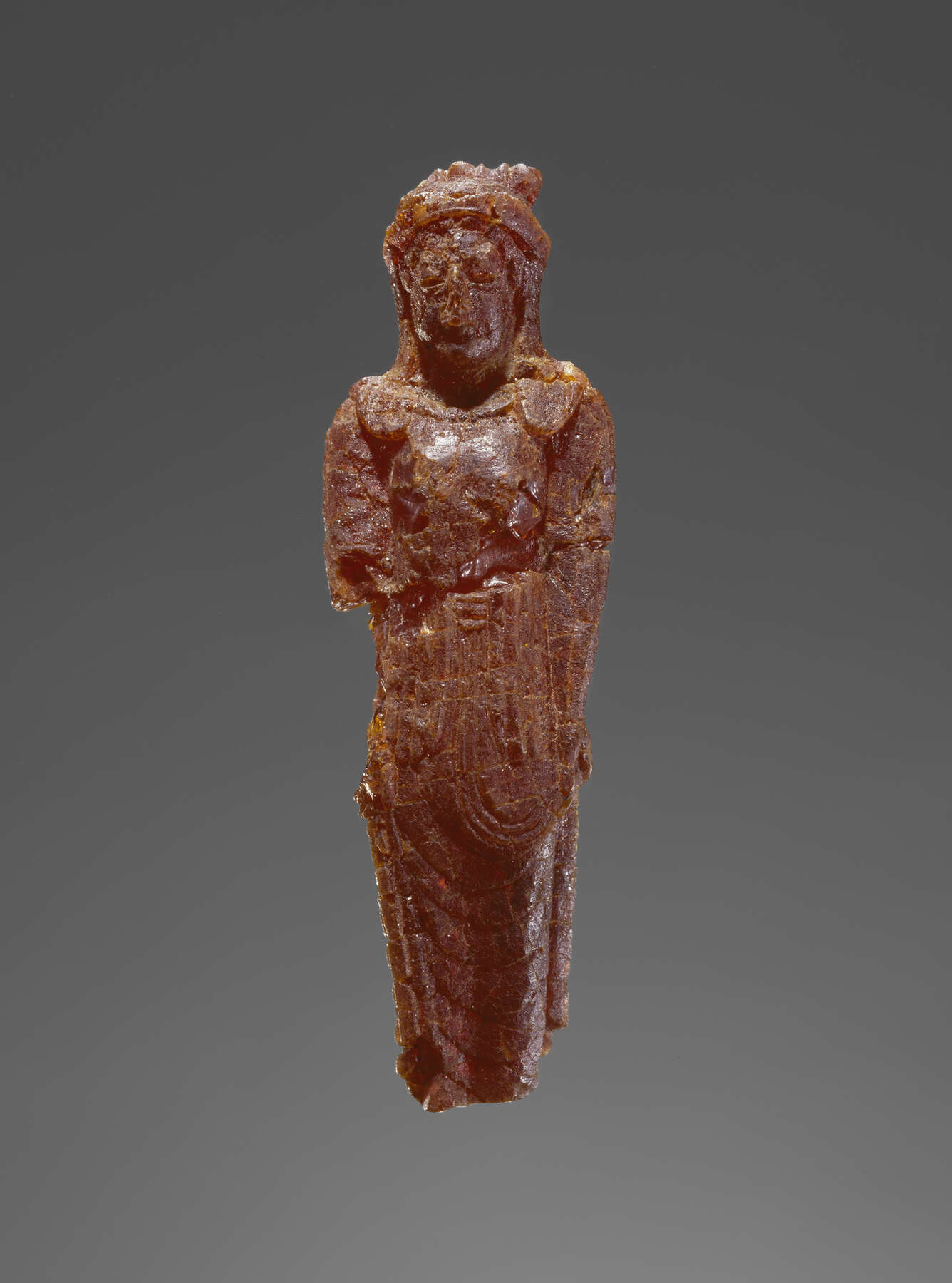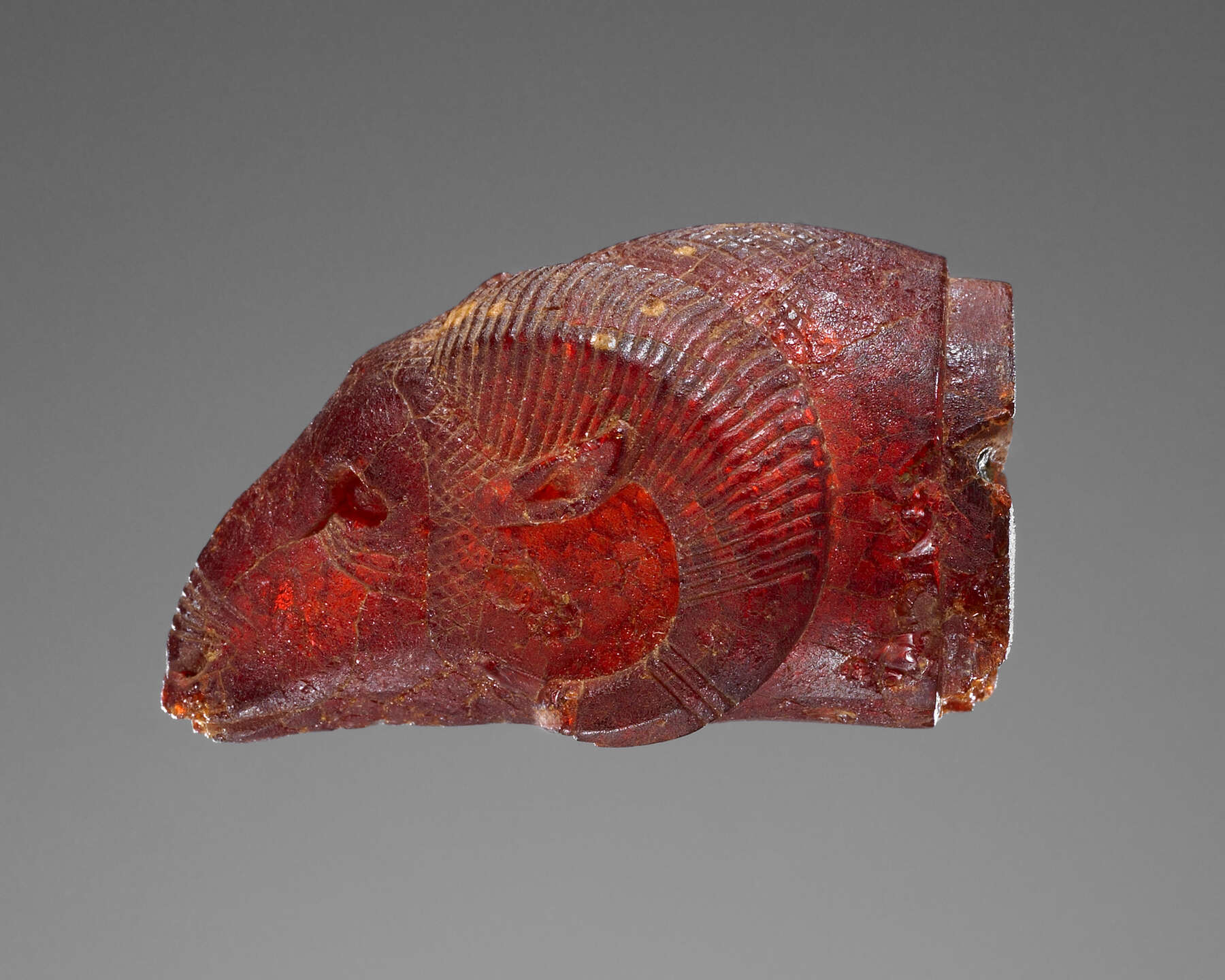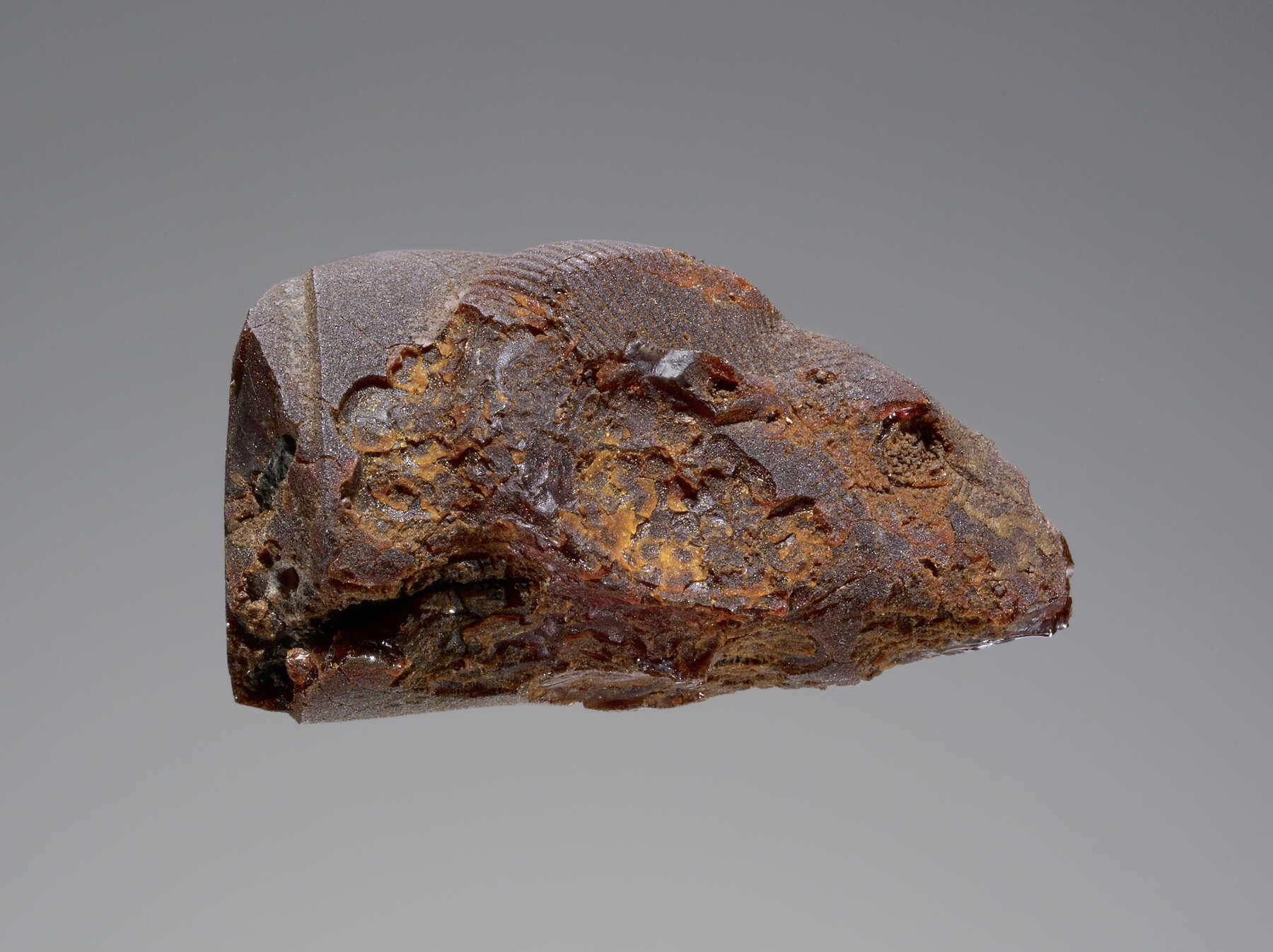37. Pendant: Foreparts of a Recumbent Boar
| Accession Number | 76.AO.84 |
| Culture | Etruscan |
| Date | 525–480 B.C. |
| Dimensions | Length (rostrocaudal): 50 mm; depth: 13 mm; height: 24.5 mm; Weight: 9.3 g |
| Subjects | Amulets; Boar; Ionia, Greece (also Ionian, Greek) |
Provenance
–1976, Gordon McLendon (Dallas, TX), donated to the J. Paul Getty Museum, 1976.
Condition
The pendant is in good condition, although it has suffered some surface degradation and losses. The surface is grainy, with cracks and crazing overall. The tip of the snout, a section of the right orbital area, and the tips of the hooves, especially on the right, are missing. There are small chips on the tips of both ears, the right side of the mandible, and the underside of the left leg. Except at the new breaks, the piece is opaque, the surface brownish tan with a pale yellow patina; in transmitted light, the reddish brown translucency of the inner structure is visible at the breaks. There are no visible inclusions.
Description
The pendant is carved fully in the round, including the head, forelegs, and upper trunk of a wild boar. The body is truncated about midway, at a point immediately behind the caudal end of the mane. The animal is in the pheonotype of repose, with its forelegs drawn up under its head. In side view, the narrow body portion of the pendant is rectangular and the head long and triangular. In frontal view, it is somewhat flat.
The anatomy of the boar is sleekly modeled, with the details of musculature revealed by subtle surface modulations in the region between the shoulder and the base of the skull. The surviving eye cavity is shallow and unfinished at the bottom edge. The lip is sharply upturned where it meets the protruding tusks and other teeth, which must have numbered three on each side, although none remain on the damaged side. The sensitively carved, leaf-shaped ears lie close to the head and point straight back. Incised marks representing bristles mark the jowls. The ridge of mane is smooth and rounded and projects only slightly above the backbone; it is incised with fine diagonal striations that point outward. The shoulder is minimized in comparison to the head and plump forelegs.
The narrowness of the animal in frontal view suggests that the artist was constrained by the thinness of the original amber blank from which this piece was worked. When suspended, the animal would have been seen in profile and hung head downward.
Discussion
There exist a number of boar-subject amber objects, but no close parallel for this pendant. The boar is an uncommon subject in pre-Roman amber and an infrequent subject generally in Greek and Etruscan jewelry; it is far more common in other media, as a figurative subject on arms and armor or ceramic vases or stamped on coinage. Except for (cat. no. 38) and a fragmentary plaque in New York,1 the other wild-boar subjects in amber are pendants or the decorative bows of fibulae. In addition to this example, there are three other pendants in the form of boars, all in the recumbent position: a pendant in New York, a more schematic example in London (British Museum 77), and a softer type, one of the numerous pendants from Tomb 102 at Braida di Vaglio.2 The boars-as-bows of fibulae are standing: an example in Cleveland arches its back (the animal is similar in form and style to 76.AO.84);3 the fibula bow in a London private collection is stiff and simplified in modeling and unrelated to any other Greek or Etruscan representation.4 Also probably meant to represent a recumbent boar is a small amber in London (BM 76), titled by Donald Strong “pendant in the form of the foreparts of a pig.”5
In style, these wild boars invite comparison with contemporary Archaic representations in other media—small bronzes, coins, gems, and paintings on vases. The boars of 76.AO.84, , the New York plaque, and the Cleveland fibula bow decoration compare especially well with the boar represented on an amygdaloidal serpentine gem in Berlin, which has been connected to Melos.6 The ambers and the gem share common forms of eyes, ears, whiskers, and mane, to cite but four key traits. They also share many sculptural similarities with a number of small sculpted bronze boars: a winged boar at bay in the Norbert Schimmel collection;7 a close parallel in the Hispanic Society, New York;8 a relative of theirs, although later and without wings, in the Walters Museum in Baltimore;9 and two early-fifth-century bronzes, a Campanian (possibly) wild boar at bay from a large, circular vessel in Boston10 and a standing boar, one of the Etruscan votive bronzes from the votive deposit of Fonte Veneziana, Arezzo.11 The two winged boars in New York present both dating and location problems, as Hans Hoffman outlined. The stylistic conventions for (the few extant) sculpted boars are virtually identical with those of the boars painted on Early and Middle Corinthian pottery. The absence of a break in the bronze boars’ manes, their taut modeling, and the rich use of incision argue against an Ionian origin for the bronzes. Hoffman concluded that the two are Greek and to be dated to the second half of the sixth century, a general attribution and date appropriate also for 76.AO.84.
76.AO.84 may have come from the same original context as the kore (, cat. no. 8) and three of the ram’s-head pendants in the Getty collection: (cat. no. 39), (cat. no. 40), and (cat. no. 41). This is plausible because of the similar condition and the similar style of the five carvings. It is suggested in the entry for the kore that it is a work of a South Ionian artisan. The resemblance of 76.AO.84 to the Melian-attributed Greek serpentine gemstone might support an East Greek connection. Further comparisons with early East Greek coinage of the late sixth to mid-fifth century B.C. with boar devices, such as that of Clazomenae and Samos, should bear fruitful results.
The wild boar plays an important role in European myth, for it was perhaps the most ferocious wild animal in Europe once lions were extinct. In Greek myth, Peleus was chased up a tree by a lion and a boar; Atys (the son of Croisus), Attis, and Adonis were slain by boars. Ultimately, it was the boar sent by Artemis (furious that King Oeneus of Calydonia had forgotten to include the goddess in his annual sacrifices to the gods) that led to the death of Meleager.
As a symbol, device, or amulet the boar could work amuletically by assimilation: the wearer, object, or building would take on the characteristics of the animal. In direct magic, a boar could frighten off danger and by extension was protective. The boar is a common blazon on Archaic armor; it might be woven into the decoration of a divine robe or mounted as protection on a building. Boar waterspouts on the corners of a sima might play an even more important role than lions’ heads flanking the sides of a temple.
Although many ancient representations of the foreparts of an active boar, including winged boars, exist—on gems, on coins, and as the blazons of shields painted on Archaic-period Greek vases—much rarer is the recumbent boar, whether complete or excerpted, as in the case of the foreparts. In general, a recumbent animal is a tamed or sleeping animal, not an active one, and this may be key to its magical function. The 76.AO.84 boar may be latently powerful; it rests in readiness, its aggressiveness to be called upon when needed to viciously protect its charge and attack danger.
Notes
- Fragmentary boar plaque: Metropolitan Museum of Art 1992.11.17, Purchase, Renée and Robert A. Belfer Philanthropic Fund, Patti Cadby Birch, and The Joseph Rosen Foundation Inc. Gifts, and Harris Brisbane Dick Fund, 1992. ↩
- Boar pendant (Etruscan or Italic) in New York: Metropolitan Museum of Art 1992.11.16, Purchase, Renée and Robert A. Belfer Philanthropic Fund, Patti Cadby Birch, and The Joseph Rosen Foundation Inc. Gifts, and Harris Brisbane Dick Fund, 1992 (, pp. 295, 473, no. 341). Boar-foreparts pendant in London: British Museum 77 (, p. 81, no. 77, pl. XXIX). Pendant from Tomb 102, Braida di Vaglio: , p. 40, pl. XLV, no. 133. ↩
- Cleveland Museum of Art 1978.124. ↩
- Unpublished. ↩
- , p. 81, no. 76, pl. XXIX. ↩
- Berlin, Antikensammlung: A. Fürtwangler, Die antiken Gemmen (Leipzig, 1900), no. 92; J. Boardman, Island Gems (London, 1963), p. 23, no. 2, pl. 1; E. Zwierlein-Diehl, Antike Gemmen in deutschen Sammlungen 2. Staatliche Museen Preussischer Kulturbesitz, Antikenabteilung, Berlin (Munich, 1969), no. 115, pl. 272; and , p. 196, figs. 306–7. ↩
- , no. 24 (H. Hoffman). ↩
- Ibid. cites as parallel the bronze boar in the Hispanic Society, New York; for which, see A. Garcia y Bellido, Hispanica Graeca 2 (1948): 28, 95–96, no. 13. ↩
- D. K. Hill, Catalogue of the Classical Bronze Sculpture in the Walters Art Gallery (Baltimore, 1949), no. 275, also cited by Hoffman (see n. 7, above). ↩
- Boston, Museum of Fine Arts 10.163 (from Sirolo): , p. 309, no. 435. ↩
- Florence, Museo Archeologico Nazionale 294: , pp. 174–79, no. 10.2; P. Bocci Paccini, “Alcuni bronzetti arcaici della ‘Fonte Veneziana,’” in Studi di Antichità in Onore di Guglielmo Maetzke (Florence, 1984), pp. 119–23; and P. Bocci Paccini, “La stipe delle Fonte Veneziana ad Arezzo,” 48 (1980): 73–91 (with additional bibl.); also illustrated in , p. 251, fig. 3.25. Like many of the other bronzes in the deposit, the boar is strongly Ionian in style. ↩
Bibliography
- Bottini and Setari 2003
- Bottini, A., and E. Setari. La necropoli italica di Braida di Vaglio in Basilicata: Materiali dallo scavo del 1994. With appendix by M. Torelli. 60, serie miscellanea 7. Rome, 2003.
- Colonna 1985
- Colonna, G., ed. Santuari d’Etruria. Exh. cat. Milan, 1985.
- Comstock and Vermeule 1971
- Comstock, M., and C. Vermeule. Greek, Etruscan, and Roman Bronzes in the Museum of Fine Arts, Boston. Greenwich, CT, 1971.
- Civiltà degli Etruschi 1985
- Cristofani, M, ed. Civiltà degli Etruschi. Exh. cat. Florence, 1985.
- Hampe and Simon 1981
- Hampe, R., and E. Simon. The Birth of Greek Art: From the Mycenaean to the Archaic Period. London, 1981.
- Norbert Schimmel Collection 1974
- Muscarella, O. W. Ancient Art: The Norbert Schimmel Collection. Mainz, 1974.
- Art of the Classical World 2007
- Picón, C. A., et al. Art of the Classical World in the Metropolitan Museum of Art. New York, 2007.
- Strong 1966
- Strong, D. E. Catalogue of the Carved Amber in the Department of the Greek and Roman Antiquities. London, 1966.





